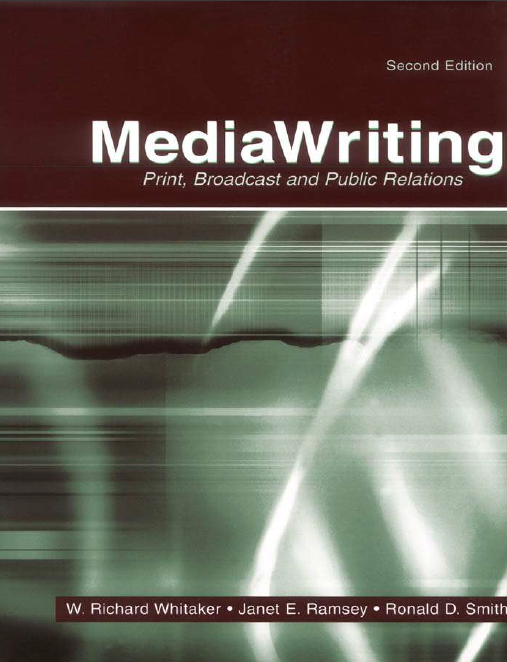
MediaWriting Print, Broadcast and Public Relations
Author: W. Richard Whitaker Category: Komunikasi ISBN: 0-8058-4688-3When the first edition of MediaWritingwas conceptualized in the mid-1990s, indus
try predictions were that media were coming together in “convergence,” spurred by
the increasingly interrelated technologies of computer, telephone, and TV. Special
ization by media, it was said, was on its way out. Print and broadcast journalists and
public relations practitioners would not be merely reporters and writers but would
increasingly be in the information-processing business, requiring overlapping skills.
America Online president Steve Case was quoted in Broadcasting magazine as noting
that media companies were positioning themselves to take advantage of a synergy of
print and video and interactive technologies and, even before the AOL-Time Warner
merger, that future media companies would be those that successfully combined
the three.
Those optimistic predictions were slightly off, of course. The full impact of
convergence has been battered by the collapse of the dot.coms and the subsequent
decline in stock values across media properties. On the other hand, hundreds of
newspapers have introduced an online presence, many with real-time streaming
audio and video. The Chicago Tribune and WGN radio and television have a con
vergent news operation, as does the Tampa Tribune and a local TV station. The
Philadelphia Inquirer, the Philadelphia Daily News, three regional newspapers, a
local television outlet and 50 radio stations have teamed up in an interactive Web
site. The pattern is replicated in many other markets around the country, where
broadcast and print reporters prepare copy for each other’s medium. Additionally,
many corporations and nonprofit organizations are using computer technology to
provide newsworthy information directly to their publics.
Instead of being merely writers and reporters, print and broadcast journalists
and public relations practitioners increasingly find themselves in the business of
information-processing and dissemination. Tomorrow’s newswriters will need to
be able to write a piece of newspaper copy designed to be read and then converted to
xvii
xviii
PREFACE
a broadcast script that can be heard or with visuals that can be seen. Internet writing
requires a mix of print and broadcast writing skills, as well as graphic talents to make
Web-based news services interesting to read. Public relations practitioners will need
the skills to produce news releases in print and broadcast versions for external media,
as information for internal organizational media, or for the organization’s Web
site.
Although traditional daily and weekly newspaper, radio and television jobs are
still available, competition for them has increased. Newspaper readership percent
ages have been on a downward spiral for years and, although online newspapers
are attracting readers, the number of daily newspapers continues to decline. Most
local radio stations have abandoned news, and audiences for TV news continue to
fragment.
Career options in this new media environment, however, have expanded dra
matically for those with interchangeable writing skills. Today’s media writers can
begin careers in a variety of magazine genres and newsletters. The Internet is pro
viding expanded opportunities. Traditional agency and corporate public relations
has expanded to nonprofit organizations, and advertising continues to be the eco
nomic backbone supporting the media. Predictions are that in less than 20 years,
media writers will be independent contractors, coming together as part of special
ized teams, working on a specific project, then leaving to start another. Today’s
media freelancer is already working in this way.
MediaWritingis designed for those who will venture into this new multimedia
environment. The textbook explores linkages between print, broadcast, and public
relations writing styles; outlines the nature of good writing; and synthesizes and
integrates professional skills and concepts. Although the subject matter is still di
vided into print, broadcast, and public relations sections—because each writing
form has a distinct style—the textbook pulls these three elements together so that at
the end of a semester or term you will have a grasp of the basic principles of media
writing.
We not only explain the “hows” of media writing but also the “whys” by dis
cussing the theoretical aspects of communication; examining legal and ethical issues;
and analyzing what makes news and how it is written and reported, how radio and
TV stations operate, and the role of the public relations practitioner in today’s media
environment. With concentrated effort on your part, you’ll possess the skills to go
on to more specialized writing courses.
MediaWriting seeks to develop professional attitudes and skills that reporters,
broadcasters, and public relations professionals need. One objective of the book
is to provide beginning newswriting students with a primer that fosters develop
ment of the talents needed for a summer job or internship at a small daily or
weekly newspaper, at a small- or medium-market radio or TV station, or in public
relations.
Back